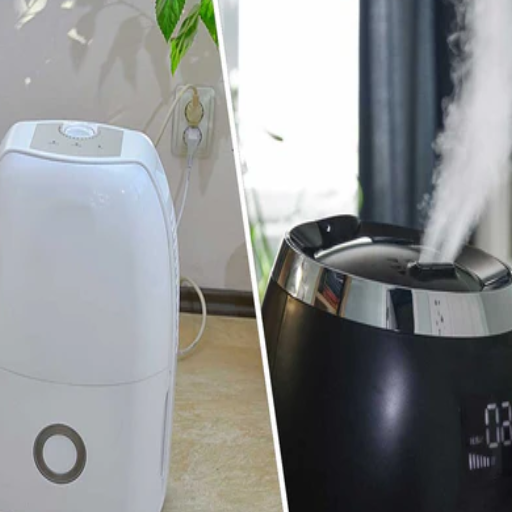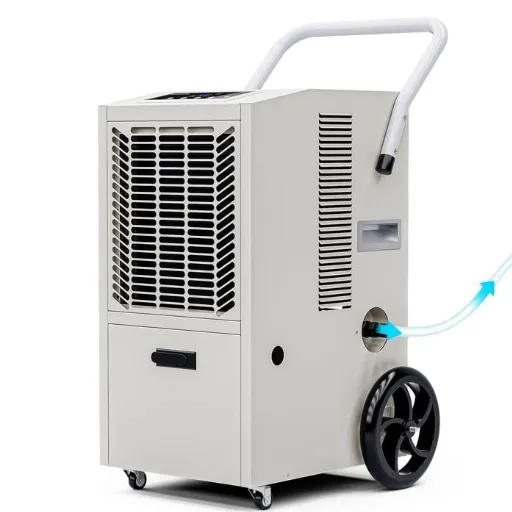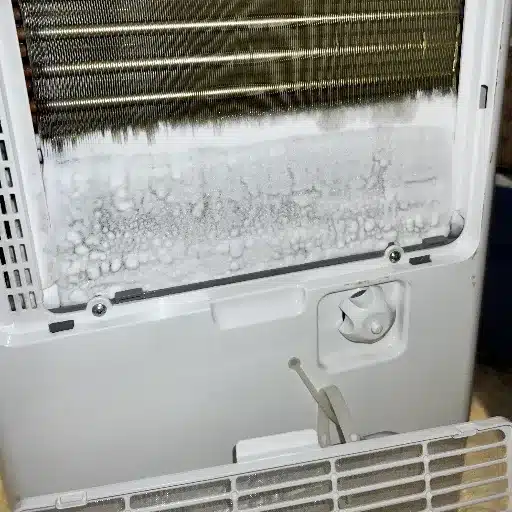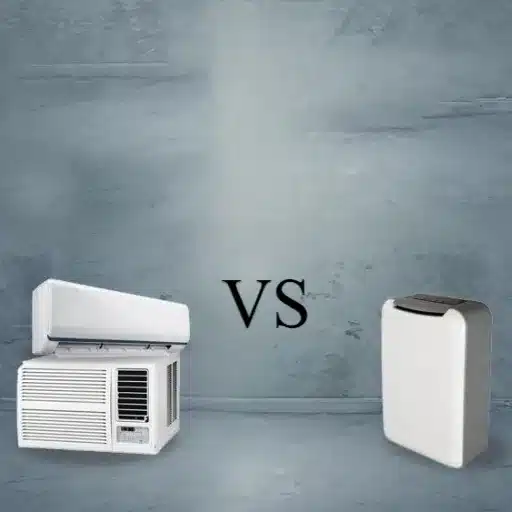Maintaining the right indoor humidity levels is crucial for creating a comfortable and healthy living environment. Too much moisture in the air can lead to problems like mold growth and dust mites, while air that’s too dry can cause irritated skin, respiratory issues, and even damage to wooden furniture. This is where humidifiers and dehumidifiers come into play. But how do you determine which device is right for your needs? In this article, we’ll break down the key differences between humidifiers and dehumidifiers, their specific functions, and how each can help you achieve optimal air quality in your home. Whether you’re battling dry winter air or struggling with excess humidity during the summer, we’ll help guide you toward the best solution for your space.
How Does a Humidifier Work?
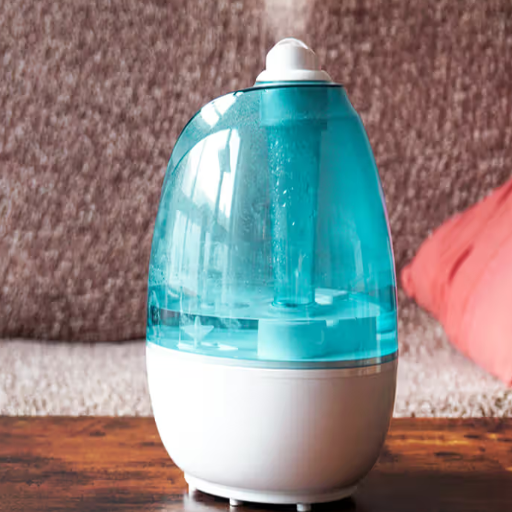
What Types of Humidifiers Are Available?
Humidifiers are classified according to their operating principles. These include evaporative, ultrasonic, steam vaporizer, impeller, central humidifiers, and more. Each type serves a different function in moisture addition; thus, it is suitable for specific conditions. So, choose a type that fits the area designated for humidification, along with personal needs.
- Evaporative: The most common type of humidifier. A fan humidifier is a which draws air through a moist wick/filter. This increases the moisture level as the water evaporates into the air. It is an energy-efficient humidifier that is self-regulating. A drawback to this model, however, is the need for regular cleaning to stop mold or bacterial growth.
- Ultrasonic: An ultrasound humidifier that uses high-frequency sound waves to agitate water, creating a mist. They are ideally quiet for use in an office or bedroom. On the downside, they are extremely sensitive to water quality. Hence, the use of tap water will make it prone to mineral and white-dust accumulation.
- Steam Vaporizers: Also known as “warm mist” humidifiers, these devices boil water to produce steam and then cool it slightly before releasing it into the air. Because of the warm mist, they help alleviate cold symptoms, but they use more energy, pose a burn hazard, especially in homes with small children.
- Impeller Humidifiers: They have a rotating disk that flings water into a diffuser, which breaks it into mist and expels it as a cool mist. They are quieter than evaporative models and are appropriate for small rooms. However, as with ultrasonic humidifiers, they can leave mineral deposits unless distilled water is used.
- Central Humidifiers: These are designed for whole-house applications. They are integrated directly into a building’s HVAC system. These systems can maintain consistent humidity levels throughout larger spaces, but need professional installation and have higher initial costs.
Understanding these types will allow you to make a choice that is most effective for your environment, health issues, and air quality needs. When making your decision, remember to look at maintenance needs, noise levels, and lifespans of these devices.
How Does a Humidifier Add Moisture to the Air?
Evaporative humidifiers make use of fan-assisted evaporation, which relies on a wick filter or vaporization evaporator. They produce steam or mist and inject it into the surrounding air, therefore increasing the humidity in that room. Another kind of humidifier is ultrasonic, which accomplishes the same goal but on a lower frequency and with better power efficiency. Both methods have claimed their respective domains for household use due to their noiseless operations during use, especially at night.
Ultrasonic humidifiers are a particular preference for use in offices since they do not create any noise during their operation and work with a higher degree of efficiency. While Ultrasonic humidifiers do come with the advantage of noiseless operations, they tend to need frequent maintenance if you wish not to have any mineral residue released into the air. Ultrasonic humidifiers also achieve higher levels of power efficiency and can switch between cooling and heating the spray produced, unlike other humidifiers.
Warm mist humidifiers operate by boiling water to produce steam, which is subsequently cooled a bit before being released into the air as mist. This method of heating water is very beneficial in killing bacteria and other microorganisms, thus making this option effective in keeping sanitary conditions. Regardless of their functionality, warm mist humidifiers tend to consume more energy than evaporative or ultrasonic options. Each humidification method has its pros and cons, but to choose one that best fulfills your needs, you need to consider your particular environment and health conditions.
When Should You Use a Humidifier?
A humidifier is helpful in places where the indoor air has a relative humidity lower than the recommended relative humidity, which is normally between 30 to 50 percent. This scenario can happen during the winter months when heating systems dry out the indoor air or in globally hot terrains. Repetitive breathing issues, insufficient moisture, poor sleep, aggravated skin, and irritated sinuses could stem from a dry indoor environment. Insufficient moisture may also lead to wood flooring and furniture being warped or cracked over a period of time.
Humidifiers are incredibly useful for people with specific conditions like asthma, allergies, or even the common cold. Patients suffering from these conditions find staining easier when their nasal cavities and air passageways are hydrated. Moreover, nosebleeds and extreme dry eye syndrome can be caused by continued exposure to dry environments, and humidifiers can work wonders in both cases.
Creating an environment filled with dust, mold, mites, and bacteria can stem from something as simple as over-humidification. Keeping a hygrometer on hand can also help monitor and set humidity to the right levels while avoiding something as bad as over-humidification. To maintain performance, clean the humidifier and replace its filters regularly to avoid releasing unclean air filled with microbes.
Understanding the Role of a Dehumidifier
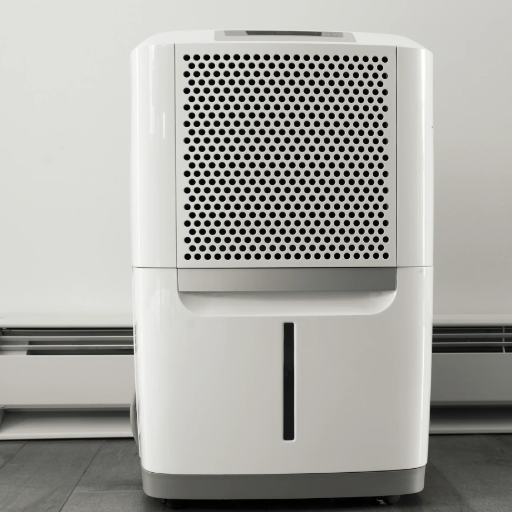
How Does a Dehumidifier Remove Moisture from the Air?
A dehumidifier lowers humidity by taking moisture out of the air using condensation. While using the dehumidifier, the device takes in humid air from the environment using a fan. This air is blown over cold coils or refrigerant-cooled surfaces. This action cools the air in the unit, leading to condensation of water vapor into droplets, which separates water vapor frthe om air flow. The water formed is drained automatically using a hose or collected in the reservoir.
Once moisture has been removed, the air is again recirculated into the room after being passed over a warm coil. This guarantees the air remains comfortable for an indoor space. Using dehumidifiers has always shown me the benefits; not only is the excess humidity removed from the air, but it also feels cooler and far less clammy, something which is extremely helpful in damp places like the basement.
Other factors, such as the size of the dehumidifier, the room temperature, and the humidity level, can impact the efficiency of this process. I calibrate the device to maintain an optimal level of humidity, which usually falls between 30-50%, ensuring proper function alongside regular maintenance. To maintain efficiency and stave off microbial growth in the unit, emptying the water reservoir and cleaning the air filters are essential tasks. This precise control over moisture is crucial for improving the health quality of indoor spaces and shielding structural components and possessions from humidity damage.
What Are the Signs You Need a Dehumidifier?
Too much humidity indoors can result in several problems, which might require a dehumidifier. One of the most noticeable issues is water condensation on windows, mirrors, or any glass, for that matter. This happens when warm, humid air cools down when it comes into contact with the surfaces, which leads to the formation of water droplets. Besides that, there is a damp or musty smell, especially in closed spaces like the basement, closets, or under the sink, which suggests that the air has more moisture than required, hence promoting mold and mildew.
Another notable sign of mold growth would be visible mildew on walls, ceilings, or tile grout. Mildew can be a health risk and can therefore compromise the indoor air quality. Exceedingly, you might notice broken wallpaper, wood, and painting that have been removed. This is a result of the excessive moisture that seeps through building materials.
Signs of health symptoms among occupants may also indicate too much moisture indoors. Increased sensitivity, respiratory issues, or chronic coughing may stem from mold spores or other microorganisms flourishing in damp conditions. Identifying these signs early allows you to effectively mitigate humidity damage by using a dehumidifier to restore reasonable moisture levels, protecting your home and inhabitants, while also improving air quality.
Benefits of Installing a Dehumidifier in Your Home
- Improved Air Quality
Dehumidifiers dry the air, which prevents the growth of mold, mildew, and dust mites, thus improving air quality. Maintaining the humidity level between 30% and 50% not only purifies the indoor air but also reduces allergens and other irritants that affect the respiratory systems and cause allergic reactions.
- Prevention of Structural Damage
Increased humidity damages the property by rotting wood, losing the paint, and triggering water damage. Thin walls and Insulations, drywall, and wood are construction materials that can be protected through dehumidifiers. As a result, the dehumidifier can improve the longevity of the building.
- Protection of Household Belongings
Important documents, clothing, and furnishings can deteriorate due to excessive moisture. Electronic devices can also be affected by becoming dysfunctional. Dehumidifiers help to protect possessions that are vulnerable to losing.
- Enhanced Energy Efficiency
Ensuring that air conditioning systems work less by reducing humidity relieves some burden placed on HVAC systems. Cooling a warm feeling may cause greater work, which decreases energy efficiency. By using dehumidifiers, the consumption of energy can be reduced by 10-15%, which would otherwise be spent in harsh, humid conditions.
- Odor Elimination
Moist spaces tend to have that unpleasant, musty smell from the growth of mold and mildew. A dehumidifier removes a significant amount of moisture, which helps mitigate these smells and improves the indoor air quality, which makes looking indoors more pleasing. This is especially helpful in places like basements, laundry rooms, and other places with poor ventilation.
Comparing Humidifiers and Dehumidifiers
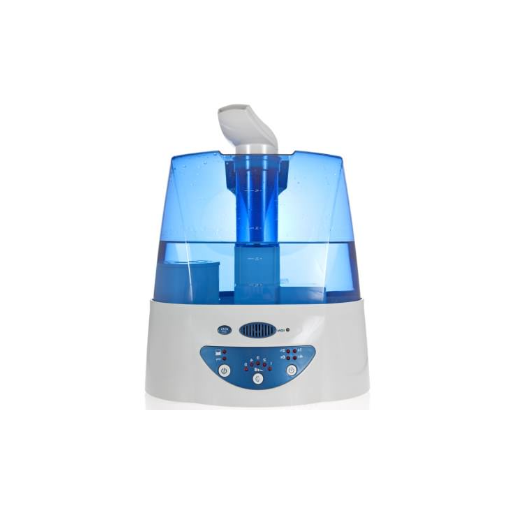
Humidifier vs Dehumidifier: What’s the Difference?
Where humidifiers moisturize the air due to dryness, dehumidifiers get rid of excess moisture in the air to lower humidity.
|
Aspect |
Humidifier |
Dehumidifier |
|---|---|---|
|
Function |
Adds moisture |
Removes moisture |
|
Scenario |
Dry conditions |
Humid conditions |
|
Optimal Range |
Below 30% RH |
Above 50% RH |
|
Typical Season |
Winter |
Summer |
|
Health Impact |
Eases dryness |
Reduces mold risk |
|
Common Issues |
Dry skin, throat |
Mold, dampness |
|
Variants |
Cool/Warm mist |
Mechanical, etc. |
|
Care Needed |
Clean regularly |
Drain the water tank |
Which is Better for Indoor Air Quality?
Choosing between a humidifier and a dehumidifier requires analyzing several specific factors and conditions of the area in question. While both devices control humidity levels, their functions differ. A humidifier can be used in the winter months or periods of low humidity when the heating systems make the air dry, because it adds moisture to the air. Moreover, maintaining a humidity level between 30%-50% can help in managing respiratory problems, reducing skin moisture, as well as lowering static electricity.
People living in extremely humid or damp regions can benefit from a dehumidifier because it helps eliminate excessive moisture from the air. Dust mites, mold, and mildew thrive in humid conditions, and they can greatly worsen the quality of air, which is detrimental for people suffering from allergies and asthma. Dehumidifiers can help maintain the appropriate level of moisture in the air, which will clean the air of these irritants and make it healthier.
Whether to choose between a humidifier or a dehumidifier largely depends on the relative humidity of your room. For your situation, a hygrometer that can measure the relative humidity of your room is crucial to have. If you tend to have a humidity level below 30%, a humidifier will do the job and restore moisture. If you tend to exceed 50%, a dehumidifier will be ideal to relieve the risks associated with damp air. By addressing the individual needs of your environment, your device helps to enhance indoor air quality, which is useful for healthier living conditions.
How to Choose: Need a Humidifier or Dehumidifier?
Evaluating a humidifier vs a dehumidifier comes down to weighing a few important factors. For one, check the relative humidity level of the space. To do so, you’ll need a hygrometer or indoor air quality monitor; both are essential. Relative Humidity %(RH) levels below 30% signify a need for a humidifier, whereas levels above 50% would require a dehumidifier to prevent excess dampness.
Next, analyze the size of the room or area that requires control. Small spaces can make do with portable tabletop units, but whole-house or larger applications tend to need integrated systems. Many modern devices come with guidelines measuring square footage and performance metrics like moisture output rate (gallons per day) or dehumidification capacity (pints per day). This precision aids in decision-making.
Perhaps the most important consideration is the feature set, or specific features of the device. Enhanced models of humidifiers include warm or cool mist options, antibacterial water tanks, adjustable humidity setting control, tanks with automatic shut-off, and more. Dehumidifiers are similar, automatically optimizing cost over time with programmable timers, continuous drain modes, and Energy Star efficiency.
Finally, people suffering from various health complications, like allergies or asthma, should consider selecting a model that has additional filtration systems. For instance, HEPA or UV filter-equipped humidifiers decrease the spread of airborne contaminants while air purifier-equipped dehumidifiers tackle mold and mildew concerns. Considering these aspects together with your individual needs helps you decide which device effectively manages humidity levels while improving air quality.
How Humidity Affects Your Indoor Air
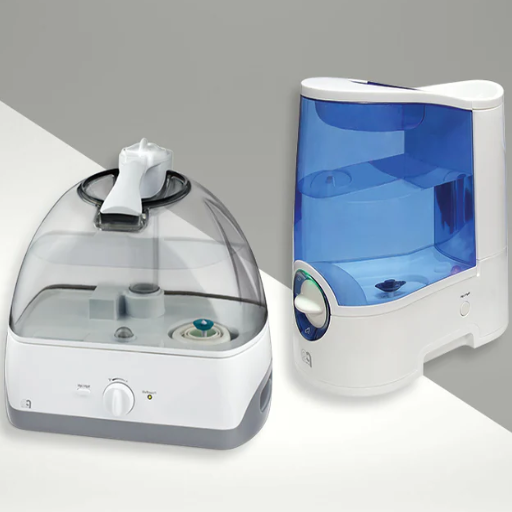
Impact of High Humidity Levels
Buildup of indoor moisture poses a severe threat to health, air quality, and domestic infrastructure. Below are five areas that can be impacted by high levels of humidity:
- Fungus Growth: High concentrations of humidity can lead to the growth of both mold and mildew. The EPA has determined that indoor humidity levels surpassing 60% allow for the growth of fungi and their spores, which can further worsen someone’s respiratory well-being and structurally damage the building.
- Increased Skeeter Populations: Dust Mites are one of the most common allergies and asthmatic triggers. For people suffering from such issues, increased levels of humidity can be severely detrimental. Studies show humidity levels of 70-80% are favored by dust mites and worsen the quality of indoor air.
- Building Materials at Risk: Constant exposure to excessive levels of moisture can severely damage the frameworks of buildings. Wood may get warped, drywall can become soft and prone to collapse, and paint bubbles can form as a result of consistently high humidity levels.
- Inhibiting Factors for Comfort and Productivity: An increase concentration of moisture in the air makes it feel warmer than it is, leading to a drop in productivity and overall discomfort. High amounts of humidity render a person’s ability to cool down through sweating useless, which leads to lethargy and drastic increases in body temperature.
- Makes Breathing Difficult: Too much humidity makes it challenging to breathe for people who already have chronic respiratory issues. Moisture levels high can worsen airflow and increase the amount of airborne irritants, worsening the symptoms for asthma and COPD patients.
In order to preserve balance within the space, humidity levels indoors should be tracked and managed frequently.
Managing Humidity in Your Home with HVAC Systems
Keeping the right amount of indoor humidity is important for comfort and health. Modern HVAC (Heating, Ventilation, and Air Conditioning) systems can do this seamlessly. Indoor humidity levels ideally stay within 30% to 50%, since they mitigate mold growth, curtail the spread of allergens, and improve air quality.
Advanced HVAC integrates automated humidifiers and dehumidifiers to maintain the correct moisture levels. Dehumidifiers are effective at removing excess moisture during humid weather, while humidifiers add moisture during clear weather to prevent skin dryness and static electricity. Moreover, smart thermostats and variable-speed fans aid in the control of airflow and temperature, which helps maintain balanced humidity control in home zones.
Proper HVAC system maintenance, such as cleaning coils, replacing filters, and performing other regularly scheduled maintenance, enhances an HVAC system’s ability to control indoor moisture. These elements assist with air flow and mitigate performance-robbing dust and moisture buildup. Data from integrated sensor controls enhances the monitoring of relative humidity levels, providing homeowners with the ability to make changes that optimize system performance. The combination of these steps promotes a healthier home while improving system lifespan and efficiency.
Why Humidity Control Matters
Managing comfort and health indoors requires actively monitoring humidity control. The previous paragraph indicates that excessive humidity fosters the development of mold, bacteria, and mildew, which is damaging to property as well as a health hazard for those with allergies, asthma, or other respiratory issues. Contrarily, too much dryness may irritate the skin, ravage the sinuses, and increase static charge, affecting sensitive electronics.
Relative indoor humidity settings advised by specialists fall between 30% and 50%, considering any value may lead to misuse of energy through HVAC systems running excessively or material damage such as paint peeling or wood warping. Incorporating hygrometers, humidity sensors, and automated dehumidifiers allows for precise regulatory control. These homes not only reap the benefits of effective energy consumption, but also enhanced air quality while facing fewer maintenance concerns and costs in utilities over time.
These integrations empower users to control humidity, propane, and air to create spaces that optimize energy balance, bolstering personal well-being and productivity while ensuring the said level enhances comfort and productivity.
Improving Indoor Air Quality with Humidifiers and Dehumidifiers
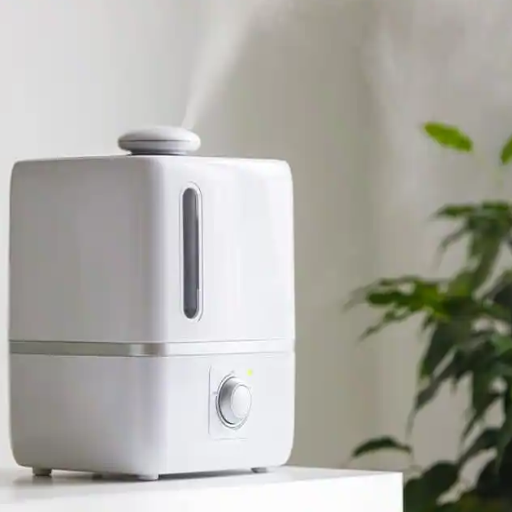
Can a Humidifier Help with Allergy and Asthma?
Research shows that optimal indoor humidity levels may alleviate perennial allergies and asthma symptoms. An indoor environment with a humidity level below 30% can lead to irritative symptoms of the disease because dry air exacerbates irritation of the mucous membranes, increasing sensitivity to allergens and other stimuli. Ultrasonically humidifying a space to 30-50% humidity can be a solution, as that both alleviates irritation and decreases the survival of airborne allergens like dust mites and mold spores.
Deterioration of the patient’s condition stems from improper use of a humidifier. Exceeding 60% humidity can foster the growth of mold and worsen the symptoms of chronic asthma. Thus, it is mandatory to use a quality humidifier with at least an integrated hygrometer sensor to control the humidity. More advanced models also feature filtration systems that eliminate allergens from the water vapor. This is important for enhancing air quality for sensitive patients.
In conjunction with other techniques aimed at improving the air quality of a space, using HEPA filters and minimizing indoor pollutants, humidifiers help to further enhance one’s respiratory condition. Customized approaches to indoor environment control should be designed with medical specialists for patients suffering from chronic asthma or intense allergies.
Preventing Mold Growth with a Dehumidifier
A dehumidifier is essential for controlling humidity levels in a building because mold development is highly sensitive to humidity levels. The relative humidity of the surroundings needs to be higher than sixty percent for mold growth, and staying at these levels for an extended period results in damage to the building and harm to the occupants. By lowering humidity with dehumidifiers, the spores of mold are inhibited from flourishing, thus protecting the property and the people living in it.
Modern dehumidifiers have advanced features such as accurate hygrometers, which take control of indoor humidity, keeping it in the range of thirty to fifty percent. Some advanced models come with programmable options, which are even more effective in removing allergens and other suspended particles. Sustained control of humidity, along with regularly maintained HVAC systems and adequate ventilation, significantly reduces the chances of mold forming.
To achieve maximum efficiency, dehumidifiers need to be placed in areas with high chances of moisture, such as bathrooms, poorly ventilated spaces, basements, and attics. The energy-efficient dehumidifiers also considerably reduce operational costs. Proper maintenance also aids in controlling the chances of secondary contamination, enhances the effectiveness of the device, and improves overall air quality.
Using Air Purifiers in Conjunction with Humidifiers
When used cooperatively, air purifiers and humidifiers can significantly improve air quality by addressing multiple areas of concern at once. Air purifiers are constructed to eliminate particulates like dust and pollen from the air using sophisticated filtration systems such as HEPA filters or activated carbon layers. In contrast, humidifiers work to mechanically maintain humidity levels to prevent the overabundance of dryness, which is harmful to breathing, skin, and static electricity, while also mitigating skin irritation and exacerbating tissues. Together, these tools not only make indoor circulation cleaner but also make indoor circulation more comfortable.
Maintaining a relative humidity of 40-60% renders airborne pathogens, such as influenza viruses, less life-threatening to humans. Furthermore, the removal of allergens and irritants using air purifiers improves general respiratory health. To ensure effective use, users must choose devices that suit the size of the room, or choose combination units that serve both functions in one device. Moreover, cleaning filters and reservoirs regularly is crucial to preventing mold from forming and encouraging optimal performance.
This method works well in cities with high levels of air pollution, as well as in colder months when people use indoor heating systems that dry out the air. By combining the advantages offered by each device, homeowners can sculpt a health-friendly environment that maintains a balance between fresh air and appropriate moisture levels.
References
- Further Investigation Of Energy And Performance Impacts Of Whole-House Dehumidifier Duct Configurations – A study on energy impacts and performance of dehumidifiers.
- Design and Optimization of a Humidifier for an HDH System – Research on humidification systems in desalination technology.
- Second Law Analysis and Optimization of Humidification-Dehumidification Desalination Cycles – Analysis of humidification-dehumidification cycles in thermal distillation.
Frequently Asked Questions (FAQ)
Q: What is the main difference between a humidifier and a dehumidifier?
A: The main difference is that a humidifier adds moisture into the air, while a dehumidifier removes moisture from the air. A humidifier can help increase the humidity level in dry environments, whereas a dehumidifier can reduce excess moisture in humid conditions.
Q: How do I determine whether you need a humidifier or a dehumidifier?
A: Whether you need a humidifier or a dehumidifier depends on the current level of humidity in your home. If the air in your home is dry, especially during winter, a humidifier may be beneficial. Conversely, if your home feels damp or if you live in a humid climate, a dehumidifier can help maintain a comfortable environment.
Q: Can a humidifier help with a cough?
A: Yes, a humidifier can help relieve a dry cough by adding moisture into the air, which can soothe irritated airways and help you breathe more comfortably.
Q: Are there different types of humidifiers?
A: Yes, there are two main types of humidifiers: cool-mist humidifiers and warm-mist humidifiers. Both types add moisture to the air but do so in different ways, and your choice may depend on personal preference and specific needs.
Q: Can dehumidifiers help reduce allergens and air pollutants?
A: Yes, dehumidifiers can help by removing excess moisture from the air, which in turn can reduce the growth of mold, dust mites, and other allergens or air pollutants that thrive in moist environments.
Q: Is running a humidifier year-round advisable?
A: Running a humidifier year-round is not typically necessary. It is usually most beneficial during the dry times of the year, such as winter, when indoor air is often dry due to heating systems.
Q: How can dehumidifiers benefit those with respiratory issues?
A: Dehumidifiers can help those with respiratory issues by maintaining an optimal level of humidity, which can prevent mold and dust mites, both of which can exacerbate breathing problems and allergies.
Q: Can air conditioning systems replace the need for a dehumidifier?
A: While an air conditioner can help reduce humidity to some extent, it may not be as effective as a dehumidifier at removing high levels of moisture from the air, especially in extremely humid climates.
Q: Are there whole-home solutions for managing humidity levels?
A: Yes, whole-home solutions, such as whole-home humidifiers or dehumidifiers, can be integrated into your HVAC system to maintain optimal humidity levels throughout the entire house.
Q: Can a heat pump assist with humidity control?
A: A heat pump can assist in controlling humidity to a degree by circulating air back into the room and maintaining a consistent temperature, but it may not replace the need for a humidifier or dehumidifier, depending on the cause and level of humidity.

